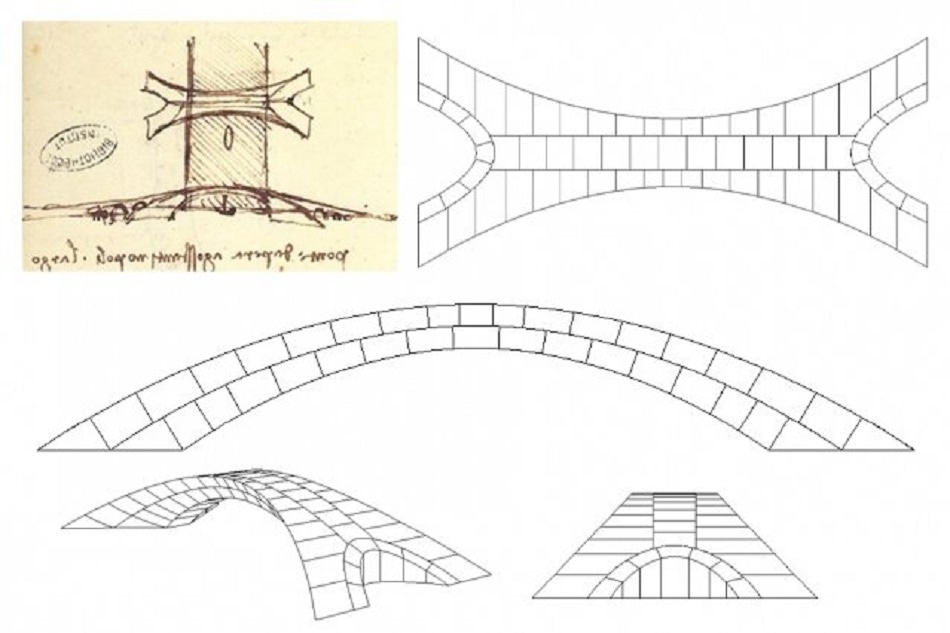
Image credit: Karly Bast and Michelle Xie / MIT
Best known for his paintings and drawings which include the Mona Lisa, Last Supper, and Vitruvian Man, Leonardo da Vinci transcended the ages, influencing both his Renaissance contemporaries as well as modern day artists and scholars.
During his time there was little exclusivity between studies in science and the arts and Da Vinci was a keen inventor, sketching engineering designs ranging from flying machines to hydraulic pumps.
True to form, the lasting influence of Da Vinci continues to dazzle and guide researchers but this time it’s one of his lesser known works leaving an impression. MIT researchers have been captivated by the design sketches for a bridge that would have spanned just over 240 meters which would have made it the world’s longest bridge during its time.
The plans for the bridge were in response to an open call in 1502 from Sultan Bayezid II who desired a connection between Istanbul and its neighboring city Galata. While Da Vinci’s design was rejected by the Sultan, the team of engineers at MIT had their intrigue piqued by the concept which led to them fabricating and testing the bridge using a 3D printing technique. "It was time-consuming, but 3D printing allowed us to accurately recreate this very complex geometry." stated Katy Bast, an MIT graduate student.
Working with a team of academics including professor of architecture and civil engineering, John Ochsendorf, and undergraduate Michelle Xie, Bast’s approach to the project included an extensive analysis of Da Vinci’s documents as well as 16th Century construction methods and materials.
Furthermore, the team took into consideration the geological and topological conditions of the intended location, an estuary named Golden Horn. All of this detail enabled Bast and her colleagues to 3D print an accurate scale model of the bridge and test whether it would endure the environmental conditions as well as being able to successfully bear weight.
Methods of bridge construction and masonry back in Da Vinci’s time relied on the use of multiple semicircular arches which would then have required solid piers to support the structure and transfer the loads. However, Da Vinci’s sketches showed a radically unfamiliar design which was a colossal singular arch that would span the entire length of the bridge and still be tall enough to allow boat masts to pass underneath. “It’s incredibly ambitious,” Bast says. “It was about 10 times longer than typical bridges of that time.”
After conducting her extensive research and analysis of Da Vinci’s notebooks and letters to the Sultan, Bast concluded that the material most likely used for the bridge would have been stone supported only by the weight of gravity. While, Da Vinci’s design and geometry has long been questioned he even accounted for potential lateral shifts of the surrounding terrain by incorporating abutments that would diverge and spread to support swaying ground movement.
Therefore, to really put the design to the test the MIT team figured the best way would be to divide the overall shape into individual geometric sections.
Had Da Vinci won the commission over 500 years ago the bridge would have required thousands of stone blocks to complete the idiosyncratic plans he devised. However, using the 3D printer the team settled on the much-smaller number of 126 blocks at a scale of 1 to 500. Each block took around 6 hours to print.
It was time-consuming, but 3D printing allowed us to accurately recreate this very complex geometry.
Katy Bast
There are others that have also been inspired by this exact Da Vinci bridge design. In Norway a scale pedestrian bridge was constructed based on the sketches but incorporating modern materials such as concrete and steel. This kind of recreation does not put Da Vinci’s engineering to the test supported by Bast’s statement, “That was not a test to see if his design would work with the technology from his time.”
Due to the nature of masonry using gravity to support a structure the MIT team’s scale model would be more faithful to the original plans and put Da Vinci’s skill to the test. “It’s all held together by compression only,” Bast stated. “We wanted to really show that the forces are all being transferred within the structure.” Using a scaffold to support the assembly each of the blocks was positioned and once the keystone was put into place the team could then remove the supporting scaffold.
Bast recalls the moment of realization that Da Vinci had indeed displayed his aptitude for being a skillful design engineer as they inserted the keystone: “When we put it in, we had to squeeze it in. That was the critical moment when we first put the bridge together. I had a lot of doubts” she claimed. “But when I put the keystone in, I thought, ‘this is going to work.’ And after that, we took the scaffolding out, and it stood up.”
While the success of the project demonstrates the ingenuity of arguably the most prolific figure of the Renaissance, Da Vinci’s design does not offer modern bridge designers or engineers much in the way of practicality. But due to 3D printing techniques and faith in the work Bast and her team showed that great ideas can come from limited technology and resources. “It’s the power of geometry,” she said, “This is a strong concept. It was well thought out.”
Disclaimer: The views expressed here are those of the author expressed in their private capacity and do not necessarily represent the views of AZoM.com Limited T/A AZoNetwork the owner and operator of this website. This disclaimer forms part of the Terms and conditions of use of this website.